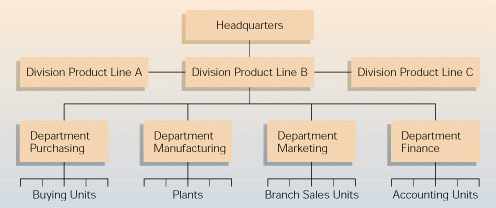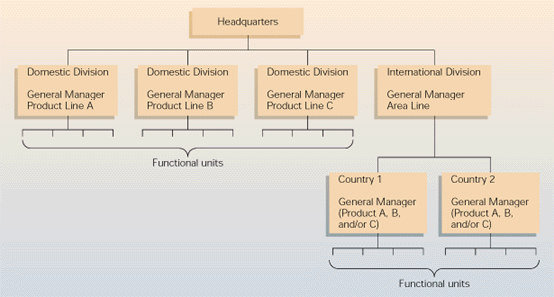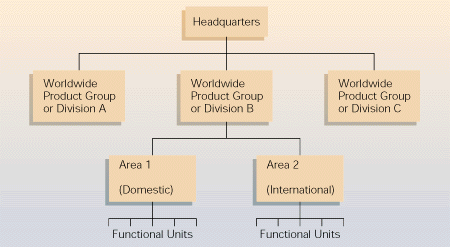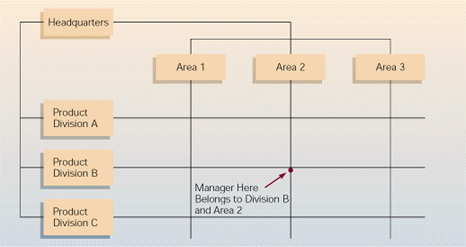Texts belong to their owners and are placed on a site for acquaintance.
Horizontal Differentiation
Horizontal differentiation is basically concerned with how the firm decides to divide itself into subunits.5 The decision is typically made on the basis of function, type of business, or geographical area. In many firms, just one of these criteria predominates, but more complex solutions are adopted in others. This is particularly likely in the case of international firms, where the conflicting demands to organize the company around different products (to realize location and experience curve economies) and different national markets (to remain locally responsive) must be reconciled. One solution to this dilemma is to adopt a matrix structure that divides the organization on the basis of both products and national markets. In this section, we look at some different ways firms divide themselves into subunits.
The Structure of Domestic Firms
Most firms begin with no formal structure and as they grow, the demands of management become too great for one individual to handle. At this point, the organization is typically split into functions reflecting the firm's value creation activities (e.g., finance, production, marketing, R&D). These functions are typically coordinated and controlled by a top-management team (see Figure 13.1). Decision making in this functional structure tends to be centralized.
Further horizontal differentiation may be required if the firm significantly diversifies its product offering. For example, although Philips NV started as a lighting company, it now also has activities in consumer electronics (e.g., visual and audio

Figure 13.1
A Typical Functional Structure

Figure 13.2
A Typical Product Division Structure
equipment), industrial electronics (integrated circuits and other electronic components), and medical systems (CT scanners and ultrasound systems). In such circumstances, a functional structure can be too clumsy. Problems of coordination and control arise when different business areas are managed within the framework of a functional structure.6 It becomes difficult to identify the profitability of each distinct business area, and it is difficult to run a functional department, such as production or marketing, if it is supervising the value creation activities of several business areas.
To solve the problems of coordination and control, most firms switch to a product division structure at this stage (see Figure 13.2). With a product division structure, each division is responsible for a distinct product line (business area). Thus, Philips has divisions for lighting, consumer electronics, industrial electronics, and medical systems. Each product division is set up as a self-contained, largely autonomous entity with its own functions. The responsibility for operating decisions is typically decentralized to product divisions, which are then held accountable for their performance. Headquarters is responsible for the overall strategic development of the firm and for the financial control of the various divisions.
The International Division
Historically, when firms have expanded abroad they have typically grouped all their international activities into an international division. This has tended to be the case for firms organized on the basis of functions and for firms organized on the basis of product divisions. Regardless of the firm's domestic structure, its international division tends to be organized on geography. This is illustrated in Figure 13.3 for a firm whose domestic organization is based on product divisions.
Many manufacturing firms expanded internationally by exporting the product manufactured at home to foreign subsidiaries to sell. Thus, in the firm illustrated in Figure 13.3, the subsidiaries in Countries 1 and 2 would sell the products manufactured by Divisions A, B, and C. In time it might prove viable to manufacture the product in each country, and so production facilities would be added on a country-by-country basis. For firms with a functional structure at home, this might mean replicating the functional structure in every country in which the firm does business. For firms with a divisional structure, this might mean replicating the divisional structure in every country in which the firm does business.
This structure has been widely used; according to a Harvard study, 60 percent of all firms that have expanded internationally have initially adopted it. Nonetheless,

Figure 13.3
One Company's International Division Structure
it gives rise to problems.7 The dual structure it creates contains inherent potential for conflict and coordination problems between domestic and foreign operations. The heads of foreign subsidiaries are not given as much voice in the organization as the heads of domestic functions (in the case of functional firms) or divisions (in the case of divisional firms). Rather, the head of the international division is presumed to be able to represent the interests of all countries to headquarters. This relegates each country's manager to the second tier of the firm's hierarchy, which is inconsistent with a strategy of trying to expand internationally and build a true multinational organization.
Another problem is the implied lack of coordination between domestic operations and foreign operations, which are isolated from each other in separate parts of the structural hierarchy. This can inhibit the worldwide introduction of new products, the transfer of core competencies between domestic and foreign operations, and the consolidation of global production at key locations so as to realize location and experience curve economies. An example of these problems is given in the accompanying Management Focus, which looks at the experience of Abbott Laboratories with an international division structure.
Because of such problems, most firms that continue to expand
internationally abandon this structure and adopt one of the worldwide
structures we discuss next. The two initial choices are a worldwide product
division structure, which tends to be adopted by diversified firms that
have domestic product divisions, and a worldwide area structure, which
tends to be adopted by undiversified firms whose domestic structures are
based on functions. These two alternative paths of development are illustrated
in Figure 13.4. The model in the figure is referred to as the international
structural stages model and it was developed by John Stopford and Louis
Wells.8

Figure 13.4
The International Structural Stages Model
Source: Adapted from John M. Stopford and Louis T. Wells, Strategy and Structure of the Multinational Enterprise (New York: Basic Books, 1972).

Figure 13.5
A Worldwide Area Structure
Worldwide Area Structure
A worldwide area structure tends to be favored by firms with a low degree of diversification and a domestic structure based on function (see Figure 13.5). This structure divides the world into areas. An area may be a country (if the market is large enough) or a group of countries. Each area tends to be a self-contained, largely autonomous entity with its own set of value creation activities (e.g., its own production, marketing, R&D, human resources, and finance functions). Operations authority and strategic decisions relating to each of these activities are typically decentralized to each area, with headquarters retaining authority for the overall strategic direction of the firm and overall financial control.
This structure facilitates local responsiveness. Because decision-making responsibilities are decentralized to each area, each area can customize product offerings, marketing strategy, and business strategy to the local conditions. The weakness of the structure is that it encourages fragmentation of the organization into highly autonomous entities. This can make it difficult to transfer core competencies between areas and to undertake the rationalization in value creation activities required for realizing location and experience curve economies. The structure is consistent with a multidomestic strategy but with little else. Thus, firms structured on this basis may encounter significant problems if local responsiveness is less critical than reducing
Figure 13.6
A Worldwide Area Product Division Structure

costs or transferring core competencies for establishing a competitive advantage in their industry. For an example of the nature of such problems, see the closing case about Unilever.
Worldwide Product Division Structure
A worldwide product division structure tends to be adopted by firms that are reasonably diversified and, accordingly, originally had domestic structures based on product divisions. As with the domestic product division structure, each division is a self-contained, largely autonomous entity with full responsibility for its own value creation activities. The headquarters retains responsibility for the overall strategic development and financial control of the firm (see Figure 13.6).
Underpinning the organization is a belief that the various value creation activities of each product division should be coordinated by that division worldwide. Thus, the worldwide product division structure is designed to help overcome the coordination problems that arise with the international division and worldwide area structures (see the Management Focus on Abbott Laboratories for a detailed example). This structure provides an organizational context in which it is easier to pursue the consolidation of value creation activities at key locations necessary for realizing location and experience curve economies. It also facilitates the transfer of core competencies within a division's worldwide operations and the simultaneous worldwide introduction of new products. The main problem with the structure is the limited voice it gives to area or country managers, since they are seen as subservient to product division managers. The result can be a lack of local responsiveness, which, as we saw in Chapter 12, can be a fatal flaw.
Global Matrix Structure
Both the worldwide area structure and the worldwide product division structure have strengths and weaknesses. The worldwide area structure facilitates local responsiveness, but it can inhibit the realization of location and experience curve economies and the transfer of core competencies between areas. The worldwide product division structure provides a better framework for pursuing location and experience curve economies and for transferring core competencies, but it is weak in local responsiveness. Other things being equal, this suggests that a worldwide area structure is more appropriate if the firm's strategy is multidomestic, whereas a worldwide product division structure is more appropriate for firms pursuing global or international strategies. However, as we saw in Chapter 12, other things are not equal; most important, as Bartlett and Ghoshal have argued, to survive in some industries, firms must adopt a transnational strategy. That is, they must focus simultaneously on realizing location

Figure 13.7
A Global Matrix Structure
and experience curve economies, on local responsiveness, and on the internal transfer of core competencies (worldwide learning).9
Many firms have attempted to cope with the conflicting demands of a transnational strategy by using a matrix structure. In the classic global matrix structure, horizontal differentiation proceeds along two dimensions: product division and geographical area (see Figure 13.7). The basic philosophy is that responsibility for operating decisions pertaining to a particular product should be shared by the product division and the various areas of the firm. Thus, the nature of the product offering, the marketing strategy, and the business strategy to be pursued in Area 1 for the products produced by Division A are determined by conciliation between Division A and Area 1 management. It is believed that this dual decision-making responsibility should enable the firm to simultaneously achieve its particular objectives. In most classic matrix structures, dual responsibility is reinforced by giving product divisions and geographical areas equal status within the organization. Individual managers belong to two hierarchies (a divisional hierarchy and an area hierarchy) and have two bosses (a divisional boss and an area boss).
Unfortunately, the global matrix structure often does not work as well as the theory predicts. In practice, the matrix often is clumsy and bureaucratic. It can require so many meetings that it is difficult to get any work done. Often, the need to get an area and a product division to reach a decision slows decision making and produces an inflexible organization unable to respond quickly to market shifts or to innovate. The dual-hierarchy structure can also lead to conflict and perpetual power struggles between the areas and the product divisions, catching many managers in the middle. To make matters worse, it can prove difficult to ascertain accountability in this structure. When all critical decisions are the product of negotiation between divisions and areas, one side can always blame the other when things go wrong. As a manager in one global matrix structure, reflecting on a failed product launch, said to the author, "Had we been able to do things our way, instead of having to accommodate those guys from the product division, this would never have happened." (A manager in the product division expressed similar sentiments.) Such finger pointing can compromise accountability, enhance conflict, and allow headquarters to lose control over the organization.
In light of these problems, many transnational firms are now trying to build "flexible" matrix structures based on firmwide networks and a shared culture and vision rather than on a rigid hierarchical arrangement. Dow Chemical, which is profiled in the accompanying Management Focus, is one such firm. Within such companies, the informal structure plays a greater role than the formal structure. We discuss this issue when we consider informal integrating mechanisms in the next section.